Nutritious Seaweeds!
Seaweeds—marine macroalgae—are packed with beneficial nutrients, from minerals to fiber to unique polysaccharides that aren’t found in land plants or in sea animals. Humans, plants, and other animals can benefit from the nutritional abundance that seaweeds offer.
Seaweeds live and grow awash in the mineral richness of the ocean, and they are especially good at extracting and in some cases, accumulating, the ocean’s dissolved minerals and trace elements. This includes a wide range of minerals such as calcium, magnesium, and potassium, and trace elements (micronutrients) such as chromium, vanadium, and boron.
According to some sources, seaweeds provide all of the dozens of minerals and trace elements needed for human health. The minerals in seaweeds also tend to be in chelated or colloidal forms that are easier to absorb and assimilate.
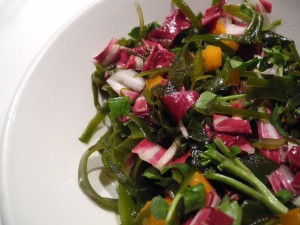 |
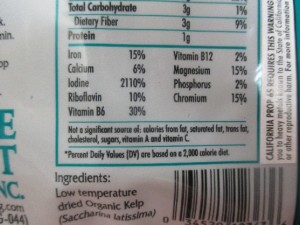 |
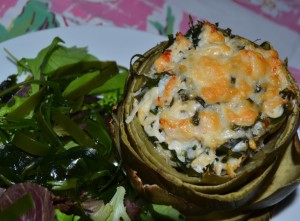 |
| Seaweed salad Photo: Tollef Olson |
Kelp and crab stuffed artichoke Photo: Tollef Olson |
Iodine is one of the minerals that is abundant in the ocean, and is accumulated to varying degrees by seaweeds. Some kelps, for example, can concentrate iodine up to 100,000 times that of surrounding seawater. Iodine is crucial for human health, and not found in substantial amounts in many foods. Iodine is essential for thyroid functioning, and also for the health of many other parts and systems of our bodies—from breasts to skin. Many sources recognize that seaweeds are one of the best food sources of iodine on the planet.
The salty taste of seaweed comes not just from sodium but a range of other mineral “salts,” particularly potassium. Intake of higher amounts of potassium than of sodium is recommended for good health, but modern diets, heavy in processed rather than fresh or whole foods, tend to be heavy on sodium and light on potassium. Seaweeds generally contain more potassium than sodium, and in some cases have comparable potassium levels to foods such as bananas that are recognized as good potassium sources.
Seaweeds also provide vitamins (A, Bs, C, E, K, possibly D), essential fatty acids such as omega-3s, and high-quality proteins, in many cases with all or most of the essential amino acids. In fact, the amino acid glutamate might sound familiar. It is the natural form that synthesized monosodium glutamate (MSG) was created to mimic, and helps to impart the “umami” taste of seaweed—also called the “fifth taste,” and similar but so much more complex than “savory.”
Seaweeds may be a rare non-animal source of Vitamin B12, though it isn’t yet clear if the B12 they contain is true B12 or an “analogue” form that looks like B12 but doesn’t act the same or have the same benefits. One view is that the B12 in seaweeds actually comes from microbes associated with the seaweed.
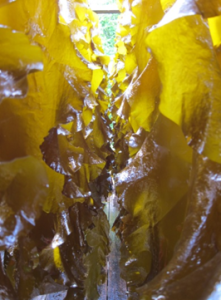 |
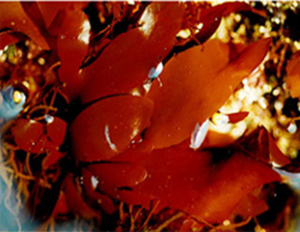 |
| Sugar Kelp (Saccharina latissima) Photo: Maine Coast Sea Vegetables |
Dulse comes in brilliant red and purple hues Photo: Maine Coast Sea Vegetables |
The nutritional benefits of seaweeds don’t stop at vitamins, minerals, good fats and high-quality proteins. Seaweeds also contain other bioactive compounds that can have effects ranging from inhibiting cancer growth, protection from viruses, to helping to modulate blood pressure and promote healthy blood coagulation. One such compound, fucoidan, is found in “brown” seaweeds such as kelps, Rockweed (Ascophyllum nodosum), and Bladderwrack (Fucus vesiculosus), and has been studied quite extensively (including almost 700 citations in PubMed in the past ten years). In some studies fucoidanhas shown anti-cancer, antiviral, anti-coagulant, and antioxidant properties, among others.
We are often reminded that fiber helps our bodies in myriad ways—from promoting healthy digestion and elimination, to feeding the colonies of beneficial bacteria and other microbes in our guts, to helping to sweep out unwanted material from our digestive tracts and modulate blood sugar fluctuations. The fiber, both soluble and insoluble, that seaweeds provide comes in relatively small amounts, but substantial percentages of the seaweed as a whole. Much of this fiber is in the form of complex polysaccharides (sugars), some of which are unique to seaweeds and offer other health benefits as well.
Pigments such as fucoxanthin in brown seaweeds, phycocyanin in “red” seaweeds, e.g., Dulse (Palmaria palmata) and Nori (Pyropia species), as well as the more commonly recognized chlorophylls, not only give vibrant color but also have properties such as antioxidant activity, passing these benefits on to seaweed consumers.
It is important to note that the nutritional composition of seaweeds varies with seasonal and environmental factors, such as geography, light intensity, temperature, season, tidal and current flow, predation, age and part of the “plants,” and how the seaweed is harvested, dried, and stored.
SOURCES:
Burtin, P. 2003. Nutritional value of seaweeds. Electronic Journal of Environmental, Agricultural and Food Chemistry. 2(4): 498-503.
Cooksley, VG. 2007. Seaweed: Nature’s Secret to Balancing Your Metabolism, Fighting Disease, and Revitalizing Body and Soul. New York: Stewart, Tabori and Chang. 206 p.
Dawczynski C, Schubert R, Jahreis G. 2007. Amino acids, fatty acids, and dietary fibre in edible seaweed products. Food Chemistry. 103:891-899.
Guiry, MD. 2015. The Seaweed Site. http://www.seaweed.ie/
Holdt, SL and Kraan S. 2011. Bioactive compounds in seaweed: functional food applications and legislation. Journal of Applied Phycology. 23:543-597.
Kim, S-K (Ed). 2011. Handbook of Marine Macroalgae: Biotechnology and Applied Phycology. Hoboken, NJ: Wiley. 592 p.
Lordan S, Ross RP, and Stanton C. 2011. Marine bioactives as functional food ingredients: potential to reduce the incidence of chronic diseases. Marine Drugs. 9:1056-1100.
MacArtain P, Gill CIR, Brooks M, Campbell R, and Rowland IR. 2007. Nutritional value of edible seaweeds. Nutrition Reviews. 65:535-543.
Mouritsen, OG. 2013. Seaweeds: Edible, Available, Sustainable. Chicago: The University of Chicago Press. 304 p.
Rhatigan P. 2009. Irish Seaweed Kitchen: The Comprehensive Guide to Healthy Everyday Cooking with Seaweeds. Dublin: Booklink. 287 p.
Ruperez P. 2002. Mineral content of edible marine seaweeds. Food Chemistry 79:23-26.